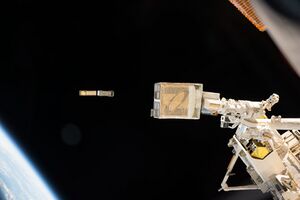Engineering:IceCube (spacecraft)
From HandWiki
Short description: Satellite
IceCube, also known as Earth-1,[1] is a 3U CubeSat satellite[2] funded by NASA[3][4] deployed by the International Space Station on 16 May 2017.[3]
 CXBN-2 and IceCube being deployed by the NanoRacks CubeSat Deployer | |
| Manufacturer | NASA |
|---|---|
| Country of origin | United States |
| Applications | Technology demonstration mission |
| Specifications | |
| Spacecraft type | CubeSat |
| Related spacecraft | |
| Derived from | CubeSats |
Mission
IceCube was built to map ice clouds globally. It has a submillimeter radiometer to overcome the limitation of ice particles in clouds being opaque in the infrared and visible spectrums.[3][5] It was made to demonstrate a 833-gigahertz submillimeter-wave receiver as part of a technology demonstration mission.[1][2][6]
See also
References
- ↑ 1.0 1.1 Garner, Rob (2015-07-21). "IceCube Satellite No Longer On Ice". http://www.nasa.gov/content/goddard/nasas-icecube-no-longer-on-ice.
- ↑ 2.0 2.1 "NASA IceCube: CubeSat Demonstration of a Commercial 883-GHz Cloud Radiometer". https://digitalcommons.usu.edu/cgi/viewcontent.cgi?article=4063&context=smallsat.
- ↑ 3.0 3.1 3.2 "IceCube - Satellite Missions - eoPortal Directory" (in en-US). https://directory.eoportal.org/web/eoportal/satellite-missions/i/icecube.
- ↑ Oreopoulos, Lazaros. "IceCube" (in en). https://atmospheres.gsfc.nasa.gov/climate/index.php?section=259.
- ↑ Blumberg, Sara (2018-05-14). "Tiny Satellite's First Global Map of Ice Clouds". http://www.nasa.gov/feature/goddard/2018/tiny-satellites-first-global-map-of-ice-clouds.
- ↑ Jenner, Lynn (2018-01-30). "NASA’s Small Spacecraft Makes 1st 883-Gigahertz Global Ice-Cloud Map". http://www.nasa.gov/feature/goddard/2018/nasa-s-small-spacecraft-produces-first-883-gigahertz-global-ice-cloud-map.
 |

